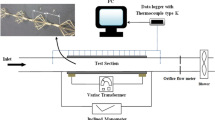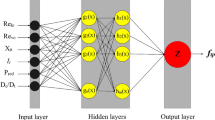Abstract
In this paper, an artificial neural network (ANN) for predicting critical heat flux (CHF) of concentric-tube open thermosiphon has been trained successfully based on the experimental data from the literature. The dimensionless input parameters of the ANN are density ratio, ρ l/ρ v; the ratio of the heated tube length to the inner diameter of the outer tube, L/D i; the ratio of frictional area, d i/(D i + d o); and the ratio of equivalent heated diameter to characteristic bubble size, D he/[σ/g(ρ l−ρ v)]0.5, the output is Kutateladze number, Ku. The predicted values of ANN are found to be in reasonable agreement with the actual values from the experiments with a mean relative error (MRE) of 8.46%. New correlations for predicting CHF were also proposed by using genetic algorithm (GA) and succeeded to correlate the existing CHF data with better accuracy than the existing empirical correlations.









Similar content being viewed by others
Abbreviations
- D he :
-
Equivalent heated diameter, (D 2i −d 2o )/D i
- D i :
-
Inner diameter of the outer heated tube (mm)
- d i :
-
Inner diameter of the inner unheated tube (mm)
- d o :
-
Outer diameter of the inner unheated tube (mm)
- d o,opt :
-
Optimum diameter of the inner tube (mm)
- ei:
-
Experimental value
- f :
-
Objective function
- g :
-
Gravitational acceleration (m/s2)
- H fg :
-
Latent heat of vaporization (kJ/kg)
- ku :
-
Kutateladze number, \( ku = [q_{\text{CHF}} /\rho_{\text{v}} H_{\text{fg}} ]/\sqrt[4]{{\sigma g\left( {\rho_{\text{l}} - \rho_{\text{v}} } \right)/\rho_{\text{v}}^{2} }} \)
- \( \overline{{ku_{j} }} \) :
-
Predictive value of ku
- L :
-
Heated tube length (mm)
- MRE:
-
Mean relative error
- N :
-
Number of CHF data
- P :
-
System pressure (MPa)
- pi:
-
ANN predicting value
- q co :
-
CHF for saturated boiling (MW/m2)
- R :
-
Correlation coefficient
- RMS:
-
Root mean square error
- ρ :
-
Density (kg/m3)
- σ :
-
Surface tension (N/m1)
- ANN:
-
Predicted by ANN
- cal:
-
Calculated
- EXP:
-
Experimental
- he:
-
Heated equivalent
- fg:
-
Liquid–vapor phase-change
- i:
-
Inner
- l:
-
Liquid
- o:
-
Outer
- v:
-
Vapor
References
Imura H, Sasaguchi K, Kozai H, Numata S (1983) Critical heat flux in a closed two-phase thermosyphon. Int J Heat Mass Transf 26(8):1181–1188
Tien CL, Chung KS (1979) Entrainment limits in heat pipes. AIAA J 17(6):643–646
Monde M (1996) Analytical study of critical heat flux in two-phase thermosyphon: relationship between maximum falling liquid rate and critical heat flux. Trans ASME J Heat Transf 118(2):422–428
Monde M, Mihara S, Mitsutake Y (1996) Experimental study of critical heat flux in open two-phase thermosyphon. Int J Heat Mass Transf 31(6):393–398
Seki N, Fukusako S, Koguchi K (1980) Single-phase heat transfer characteristics of concentric-tube thermosyphon. Wärme Stoffübertrag 14(3):189–199
Monde M, Mitsutake Y, Kubo S (1994) Critical heat flux during natural convective boiling in a vertical uniformly heated inner tubes in vertical annular tubes submerged in saturated liquid. Wärme Stoffübertrag 29(4):271–276
Mitsutake Y, Monde M, Hasan MZ (1997) Experimental study of the critical heat flux in a two-phase open concentric-tube thermosyphon. Heat Trans Jpn Res 26(5):319–331
Islam MA, Monde M, Hasan MZ, Mitsutake Y (1998) Experimental study of CHF in concentric-tube open thermosyphon. Int J Heat Mass Transf 41(23):3691–3704
Islam MA, Monde M, Hasan MZ, Mitsutake Y (1998) An experimental investigation of CHF in an open concentrictube thermosyphon, Heat Transfer 1998. In: Proceedings of the 11th International Heat Transfer Conference, Kyongju, Korea, 2:181–186
Islam MA, Monde M, Mitsutake Y (2005) CHF characteristics and correlations of concentric-tube open thermosyphon working with R22. Int J Heat Mass Transf 48(21–22):4615–4622
Moon SK, Baek WP, Chang SH (1996) Parametric trends analysis of the critical heat flux based on artificial neural networks. Nucl Eng Des 163(1–2):29–49
Moon SK, Chang SH (1994) Classification and prediction of the critical heat flux using fuzzy theory and artificial neural networks. Nucl Eng Des 150(1):151–161
Mazzola A (1997) Integrating artificial neural networks and empirical correlations for the prediction of water-subcooled critical heat flux. Rev Gen Therm 36(11):799–806
Zhao DW, Su GH, Tian WX, Sugiyama K, Qiu SZ (2008) Experimental and theoretical study on transition boiling concerning downward-facing horizontal surface in confined space. Nucl Eng Des 238(9):2460–2467
Hao Peng, Xiang Ling (2009) Neural networks analysis of thermal characteristics on plate-fin heat exchangers with limited experimental data. Appl Therm Eng 29(11–12):2251–2256
Hakeem MA, Kamil M, Arman I (2008) Prediction of temperature profiles using artificial neural networks in a vertical thermosiphon reboiler. Appl Therm Eng 28(13):1572–1579
Su GH, Morita K, Fukuda K, Pidduck M, Jia DN, Miettien J (2003) Analysis of the critical heat flux in round vertical tubes under low pressure and flow oscillation conditions, applications of artificial neural network. Nucl Eng Des 220(1):17–35
Kalogirou S (2000) Applications of artificial neural-networks for energy systems. Appl Energy 67(1–2):17–35
Irie B, Miyaki S (1988) Capabilities of three layer perceptrons. In: Proceedings of the IEEE Second International Conference on Neural Networks, San Diego, CA
Holland JH (1975) Adaptation in natural and artificial systems: an introductory analysis with applications to biology, control, and artificial intelligence. University of Michigan Press, Ann Arbor
Haj Seyed Hadi MR, Gonzalez-Andujar JL (2009) Comparison of fitting weed seedling emergence models with nonlinear regression and genetic algorithm. Comput Electron Agr 65:19–25
Author information
Authors and Affiliations
Corresponding author
Rights and permissions
About this article
Cite this article
Chen, R.H., Su, G.H., Qiu, S.Z. et al. Prediction of CHF in concentric-tube open thermosiphon using artificial neural network and genetic algorithm. Heat Mass Transfer 46, 345–353 (2010). https://doi.org/10.1007/s00231-010-0575-9
Received:
Accepted:
Published:
Issue Date:
DOI: https://doi.org/10.1007/s00231-010-0575-9




